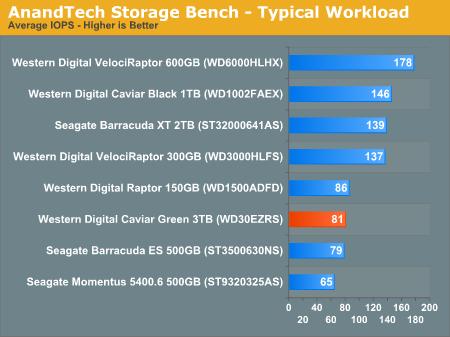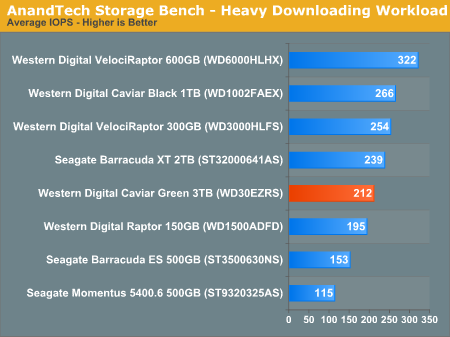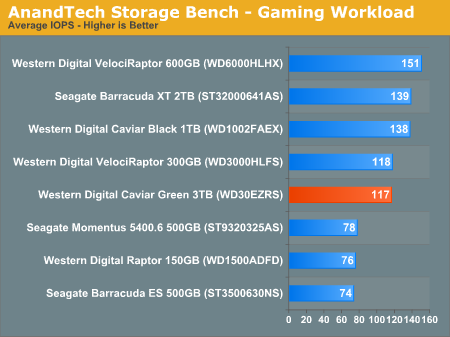Western Digital Caviar Green 3TB and My Book Essential 3TB Drives Reviewed
by Anand Lal Shimpi on October 19, 2010 1:43 PM EST- Posted in
- Storage
- HDDs
- Western Digital
- 3TB
AnandTech Storage Bench
The first in our benchmark suite is a light usage case. The Windows 7 system is loaded with Firefox, Office 2007 and Adobe Reader among other applications. With Firefox we browse web pages like Facebook, AnandTech, Digg and other sites. Outlook is also running and we use it to check emails, create and send a message with a PDF attachment. Adobe Reader is used to view some PDFs. Excel 2007 is used to create a spreadsheet, graphs and save the document. The same goes for Word 2007. We open and step through a presentation in PowerPoint 2007 received as an email attachment before saving it to the desktop. Finally we watch a bit of a Firefly episode in Windows Media Player 11.
There’s some level of multitasking going on here but it’s not unreasonable by any means. Generally the application tasks proceed linearly, with the exception of things like web browsing which may happen in between one of the other tasks.
The recording is played back on all of our drives here today. Remember that we’re isolating disk performance, all we’re doing is playing back every single disk access that happened in that ~5 minute period of usage. The light workload is composed of 37,501 reads and 20,268 writes. Over 30% of the IOs are 4KB, 11% are 16KB, 22% are 32KB and approximately 13% are 64KB in size. Less than 30% of the operations are absolutely sequential in nature. Average queue depth is 6.09 IOs.
The performance results are reported in average I/O Operations per Second (IOPS):

Real world drive performance is a bit of a letdown if you're planning on using the 3TB drive as a boot drive. It's barely any faster than an old Seagate Barracuda ES and even slower than the old 150GB VelociRaptor.
If there’s a light usage case there’s bound to be a heavy one. In this test we have Microsoft Security Essentials running in the background with real time virus scanning enabled. We also perform a quick scan in the middle of the test. Firefox, Outlook, Excel, Word and Powerpoint are all used the same as they were in the light test. We add Photoshop CS4 to the mix, opening a bunch of 12MP images, editing them, then saving them as highly compressed JPGs for web publishing. Windows 7’s picture viewer is used to view a bunch of pictures on the hard drive. We use 7-zip to create and extract .7z archives. Downloading is also prominently featured in our heavy test; we download large files from the Internet during portions of the benchmark, as well as use uTorrent to grab a couple of torrents. Some of the applications in use are installed during the benchmark, Windows updates are also installed. Towards the end of the test we launch World of Warcraft, play for a few minutes, then delete the folder. This test also takes into account all of the disk accesses that happen while the OS is booting.
The benchmark is 22 minutes long and it consists of 128,895 read operations and 72,411 write operations. Roughly 44% of all IOs were sequential. Approximately 30% of all accesses were 4KB in size, 12% were 16KB in size, 14% were 32KB and 20% were 64KB. Average queue depth was 3.59.

The more sequential the workload, the more the Caviar Green is going to behave like a normal high performance drive. In this case we're very close to the performance of Seagate's 7200RPM Barracuda XT 2GB (and presumably the upcoming 3TB version). The strong showing here is due to Western Digital's high areal density.
The gaming workload is made up of 75,206 read operations and only 4,592 write operations. Only 20% of the accesses are 4KB in size, nearly 40% are 64KB and 20% are 32KB. A whopping 69% of the IOs are sequential, meaning this is predominantly a sequential read benchmark. The average queue depth is 7.76 IOs.

Read performance is decent, but a good 7200RPM drive will still be a bit faster. The 3TB Caviar Green will serve as a good place to store movies, music and photos but if you're a gamer concerned about load times you might want to stick with a 7200RPM drive.










48 Comments
View All Comments
pvdw - Wednesday, October 20, 2010 - link
I use Linux MD RAID 10 (near-copies) on my home "server". For those who don't know, this is a non-standard RAID level that simulates RAID-10 using only two drives. In addition to redundancy this provides read speed improvements and some write speed improvement. I've set up automatic backups to protect from user error; and use Linux, so no viruses (yet). So I'm protected from all but fire/theft/bomb/hurricane/etc. For this I have off-site storage that syncs on a less frequent basis.Since we've had a number of power cuts here recently, the RAID setup also gives extra security.
Also, I don't know where you get your data from. None of my customers have lost data due to malware (I recover data from systems riddled with them), theft, or fire, but they have due to disk failure. I would put user error at the top of the list. I can see theft moving up the list due to the increase in portable data storage (tablets, smartphones, etc.)
daneren2005 - Wednesday, November 23, 2011 - link
You must be kidding me. Although it happens, not a single person I know has ever had a fire in their house. House break ins once again happen, but are not every day occurrences. I haven't heard of a widespread wipe virus since the early XP days. And when it comes right down to it, the common backup method (external HDD) prevents NONE of these things either. For 99.9% of the population, a RAID 1 provides IDENTICAL protection as an external backup drive. Especially since most consumer backups delete files that were deleted on the main drive, anything but a immediately noticed user error/virus wipe (and usually getting it out of the trash is going to be enough for these cases) would be propagated to the external drive as well.Now I both backup (update ~once a moth and store at brothers house) and RAID my data, but I do both because neither is enough by itself, but RAID isn't any less of a backup option then external backups.
CharonPDX - Tuesday, October 19, 2010 - link
I've had Intel Desktop boards for a few years that support EFI boot. I installed Windows 7 this way onto a 3 TB Intel chipset RAID a while ago, no problem. (Boot to the EFI installer on the Windows 7 disc, rather than the BIOS installer.)TSnor - Tuesday, October 19, 2010 - link
re: "Simply look at worst case seek time and you’ll get an idea for how quickly the platters are spinning" Worse case seek time should be the time it takes the heads to move from one extreme to another. While there might be a correlation between seek time and RPM, it would be because high performance drives tend to maximize both and green drives accept compromises on both.re: "Random performance is significantly lower, presumably because of the translation that happens at the USB controller level. " No, reading random 4K records is much harder for disk drives than reading sequential data. The R/W heads need to get positioned to the correct track between each random IO operation (that's the 'seek time' above) and the correct data has to rotate under the R/W heads (that's rotational latency effected by drive RPM). Reading sequential data the disk drive just reads each record as it comes under the R/W head, with a 1 cylinder (very short) seek to get to the next cylinder. This is why rotating disks can compete with SSDs for sequential data but get crushed on random data.
dertechie - Tuesday, October 19, 2010 - link
He's comparing the 4K reads of the external drive to the 4K reads of internal and other HDDs, not to sequential reads. If you actually look, you'll note that the drive lost over half of its random 4K read performance when using it over USB3 (0.18 MB/s) compared to the numbers it posts as an internal drive (0.40 MB/s). Write performance also dropped compared to internal, but not as much.TSnor - Tuesday, October 19, 2010 - link
re: "If you actually look..." ok. I agree with you.Sufo - Wednesday, October 20, 2010 - link
um, pretty sure he was comparing the internal drive to the external one here (so essentially sata to usb 3). I would be surprised if Anand had forgotten that random reads/writes are slow work on mechanical drives - it's not been that long since he published the last round of articles on the subject...Sufo - Wednesday, October 20, 2010 - link
oops sorry, didn't check next page >_<Dainas - Tuesday, October 19, 2010 - link
Anand,Can you please do some reviews on Samsung's Spinpoints? Only asking because Western Digital and Seagate always seem to have this or that issue with their +1TB drive. Also from what I've seen Samsungs efforts are also consistently faster and more reliable. Would be nice to know what you think of them.
musicman1352000 - Tuesday, October 19, 2010 - link
Yes please!Also, what happened to the noise figures?